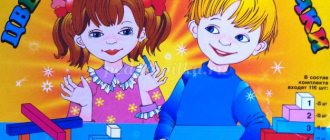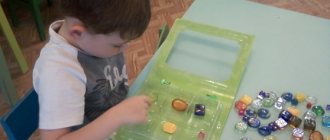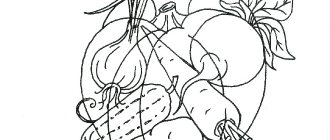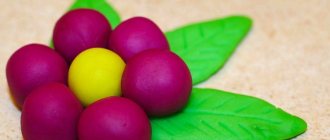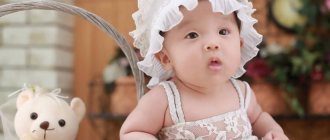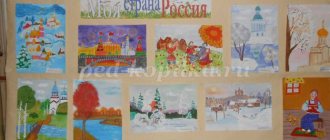Stage 1: kids play
Children 2-3 years old are unlikely to rack their brains over the problem of how to make a square out of..... They need games of a different kind, namely laying out figures, objects, and even better, fairy tales from matches.
We felt comfortable playing at a low coffee table (we have it reserved for children's creativity and games). So, we pour a few packs of matches into the middle and begin the story. For example, like this:
Once upon a time there lived a hedgehog
He had his own house
One day he met a snake
The snake lived in the thick grass
And so on: tell us about how they became friends, met a horse, a man, tried to climb a tree, and why the hedgehog didn’t succeed. The child will definitely get involved if you don’t touch him, but it’s just interesting to create, tell and build. A little time will pass and you will already be listening to fairy tales performed by your child.
Games with counting sticks in kindergarten
Methodological guide for kindergarten: “Lay out from counting sticks”
Didactic game with counting sticks for children 3 - 7 years old
Didactic game with counting sticks for preschool children
Author: Verkhoturova Lyubov Mikhailovna, additional education teacher of the first qualification category, MBOU Dubininskaya secondary school No. 13, Krasnoyarsk region, Sharypovsky district, Dubinino village Description: the work is intended for preschool children, will be of interest to everyone who loves children and knows how to unleash the child’s creative abilities in any work. Purpose: this material is recommended for preschool teachers and loving parents. Integration of educational areas: “Socialization”, “Artistic creativity”, “Health”, “Communication”, “Cognition”. Goal: development of fine motor skills of fingers in children. Objectives: Educational: -create a game environment, consolidate knowledge of colors, counting. Developmental: - develop sensory abilities; — develop constructive skills, coordination of movements; - develop creative imagination and fantasy. Educational: -to develop skills of cooperation, mutual assistance, goodwill; - to cultivate perseverance, independence in work, the ability to name what is drawn in the picture. Materials: counting sticks of different colors, cards for each child with images of familiar objects, a magic box. “Preschool teacher, educate yourself, children learn by imitating” Makarenko. Progress of the game: I. Intrigue. Educator: What do I have in my hands? Children: Box. Educator: What do you think? What's in it? Children: Beads, rings, threads, buttons. Educator: But you didn’t guess, there are objects in the box, they are thin, multi-colored, long, hard, they can be counted, now have you guessed what’s in there? Children: Pencils, twigs, counting sticks. Educator: Yes, there are counting sticks in the box, why do you think we need them, what will we do with them? Children: Play, count. Educator: That's right, we will not only count them, but also lay out drawings from them. II. Carrying out the game. Educator: I have pictures, tell me what is shown on them. Children name the pictures. Educator: Lay out a drawing from counting sticks, choosing the right color; you need to take the sticks one at a time from the box. Children complete the task. Children 3-5 years old place sticks directly on the drawing, children 6-7 years old look at the picture and lay it out on their own. You can offer to come up with your own drawing. If the child has laid out everything correctly, the teacher praises him, asks how many sticks were needed and offers to post another picture. At the end of the game, children say whether their comrades completed the task correctly. III. The result of the game.
Educator: Guys, what did we do today? Children: They laid out a pattern from sticks, drew with sticks, counted sticks, matched sticks by color, named pictures. Educator: Did you like playing with sticks? Children: Yes! Educator: Well done, you all quickly completed the task and posted beautiful drawings. 1.Sunny.
2.Truck.
3.Ship.
4.Vase.
5.Girl.
6. Christmas tree.
7.Fish.
7.Two Christmas trees.
9.Star.
10. Hedgehog.
11. Airplane.
12. Steam locomotive.
13. Flags.
14.Ladybug.
15.Boy.
16.House with a tree.
17.TV.
18.A dragonfly flies to a flower.
19.Rocket.
20.Candy.
We develop motor skills and play with counting sticks. We fix the colors, the activity is simply beautiful.
We recommend watching:
Didactic game for children from 1 to 5 years old “Family Hobbies” Do-it-yourself outdoor game “Fishing” for kindergarten Scenario of dance entertainment for children 5-7 years old Master class. Making juggling rings
Similar articles:
Games in kindergarten for children from 3 to 5 years old
Educational game in the preparatory group of kindergarten
Ball games for children 5-6 years old at home with parents
The simplest "preparatory" games
1. Make 2 triangles from 5 matches
2. Add one match to make 2 squares. (More difficult option: Add one match to make 3 quadrangles)
3. Rearrange one match so that the hare’s chair turns towards the cabbage
4. How many squares are there? What about rectangles? Is a square a rectangle?
5. Add 2 matches to make 3 squares
6. Add one match to make 3 triangles
7. Turn the tracks in the opposite direction by rearranging 4 matches
8. There is a carrot in the basket. Arrange 2 matches so that the carrot is under the basket
9. Make the letter H into the letter P by moving one match
Mathematics for preschoolers on Cuisenaire sticks. Where to start getting acquainted with chopsticks?
We offer you an overview of the exercises recorded at the webinar by the author of educational games, Bella Borisovna Finkelshtein.
Believe it or not, all the math concepts a child learns from 2nd through Pre-K can be illustrated using colored counting sticks.
Let's show this in basic game exercises.
Simple math concepts:
One and many. Many and one.
Where is one? Where is there a lot?
Comparison of sets. More less; longer is shorter.
We show the concept of equality on sticks.
Concept of numbers.
Each stick has a name, it is written
is expressed in numbers. (Cardboard numbers and signs are included with the game.)
Let's sign the blue stick, and the pink one... What's the name of the red stick, let's find a number for it!
Composition of numbers from units. How many units are in a number, so is the number.
Children's research activity: determine how many units are in a pink stick, in a black stick. The length of each stick can be indicated by a number, and when comparing, use the signs ><=
We form the idea of more, less. How much more (less). Equalization.
| 3 is more than 2 by 1 | 6 is less than 7 by 1 |
Natural series. Construction of natural series.
First stage: we build a row up to 5, the second stage - from 5 to 10. We build rows in two planes - vertical and horizontal.
Let's build a ladder! (What's the next step? Let's count! (one, two, three....)
Another research work is to prove that each subsequent number is 1 more or 1 less than the previous one.
Sticks can be combined into families:
| White family: | Black family: |
| Red family: | Blue family: |
| Yellow family: | |
| It may be noted that some numbers are included in several families. As you guessed, families combine numbers that are multiples of 2,3,5 and prime numbers. One and seven - families - singles. |
7. Composition of a number from two smaller ones.
A very effective exercise for consolidating the composition of a number from two smaller ones.
Children will not only remember the composition, but also choose the number themselves and feel the composition tactilely.
Example exercises:
We will weave rugs.
Let's weave a carpet. Let's fold the number 7 carpet:
Or we'll assemble a runway for an airplane...
It is useful to write down (code) your rug using numbers. Decoding is also interesting.
Solution of examples:
We supplement the solution of the examples with numbers and signs.
| Addition. | Subtraction: |
Drawing up problems based on models.
Children are happy to come up with problems using the proposed models for addition and subtraction.
7 sparrows were sitting on a branch, 2 more sparrows flew in, how many sparrows are sitting on the branch? There were 7 cars in the parking lot, 2 more parked.... etc. Children's imagination is limitless. What will your task be about?
Prepare to understand the operations of multiplication and division.
| Multiplication: How many rows? How many in one row? How much in total? | Division: Two is the measure of an object. |
11. Going through ten.
In many languages, the numbers of the second ten sound the same: five times ten. We take Ten (twenty) and put five on it. That makes fifteen.
Let's make thirteen, seventeen from sticks!
Names of numbers that are multiples of ten. Fifty - five tens.
What does thirty look like? or eighty?
We saw the possibilities of using sticks to solve arithmetic problems.
Consider the use of sticks in geometry.
Square.
Research work: prove that all sides of a square are equal. (Take a measurement and apply it to each side).
Rectangle. We prove the equality of opposite sides.
Triangle. We count the number of angles and sides.
Polygons, angles: right, acute, obtuse.
All of these exercises can be gradually introduced as part of a lesson (GCD).
For use in classes, you will need one box of colored Cuisenaire counting sticks for 2-3 people.
And, of course, in the educational process we use games and manuals that allow you to systematically work with colored Cuisenaire counting sticks.
| Younger age | Average age | Older age |
Description of the kit
Cuisenaire sticks are a set of 116 sticks of different colors and lengths. Total 10 colors: white, pink, blue, red, yellow, purple, black, burgundy, blue, orange.
Each color corresponds to a length. The white stick is the shortest, it is a cube 1 cm long, the orange one is the longest - 10 cm.
The table shows that all colors form three families + white, black (neutral) colors. Orange and purple are present in two families, as they appeared due to the mixing of these colors.
Making your own counting sticks
The set contains parallelepipeds ranging in size from 10 to 1 cm; they differ in color and material from which they are made. There are also instructions for colored Cuisenaire counting sticks, templates for different numbers and a manual with recommendations and a list of steps, tasks and examples. The lengths of the bars indicate numbers, and the colors indicate their classes.
The longer the stick, the larger the number; each centimeter adds one. Groups and classes are divided by shade: red - numbers that are multiples of two, green and blue are divided by three, units are indicated by white, and divisible by 5 and 10 - orange and yellow. The classic collection contains 241 sticks, but for preschoolers they produce simplified sets of 119 or 144 blocks. In some models, green is replaced by blue or purple, and red by pink.
Parents do not have to purchase a ready-made set; they can make it themselves. Sticks are made from wooden blocks or colored cardboard. The first option will allow the child to navigate not only by the shades and length of the product, but also by its volume. On the Internet you can find a table of the sizes of each block, as well as stencils and templates. They are printed and used to cut out sticks from the selected material. Wooden sticks are coated with a layer of acrylic paint in a tone corresponding to the class of numbers.
It is advisable to write numbers on cardboard products, so children will remember them faster. If classes are conducted using a magnetic board, then small magnets are also attached to the back of the blocks. Pre-prepare a box for storage. It should have different sections for each color of stick. After lessons, the child will independently arrange the blocks into the appropriate cells. This will help develop self-discipline and teach your child order.
